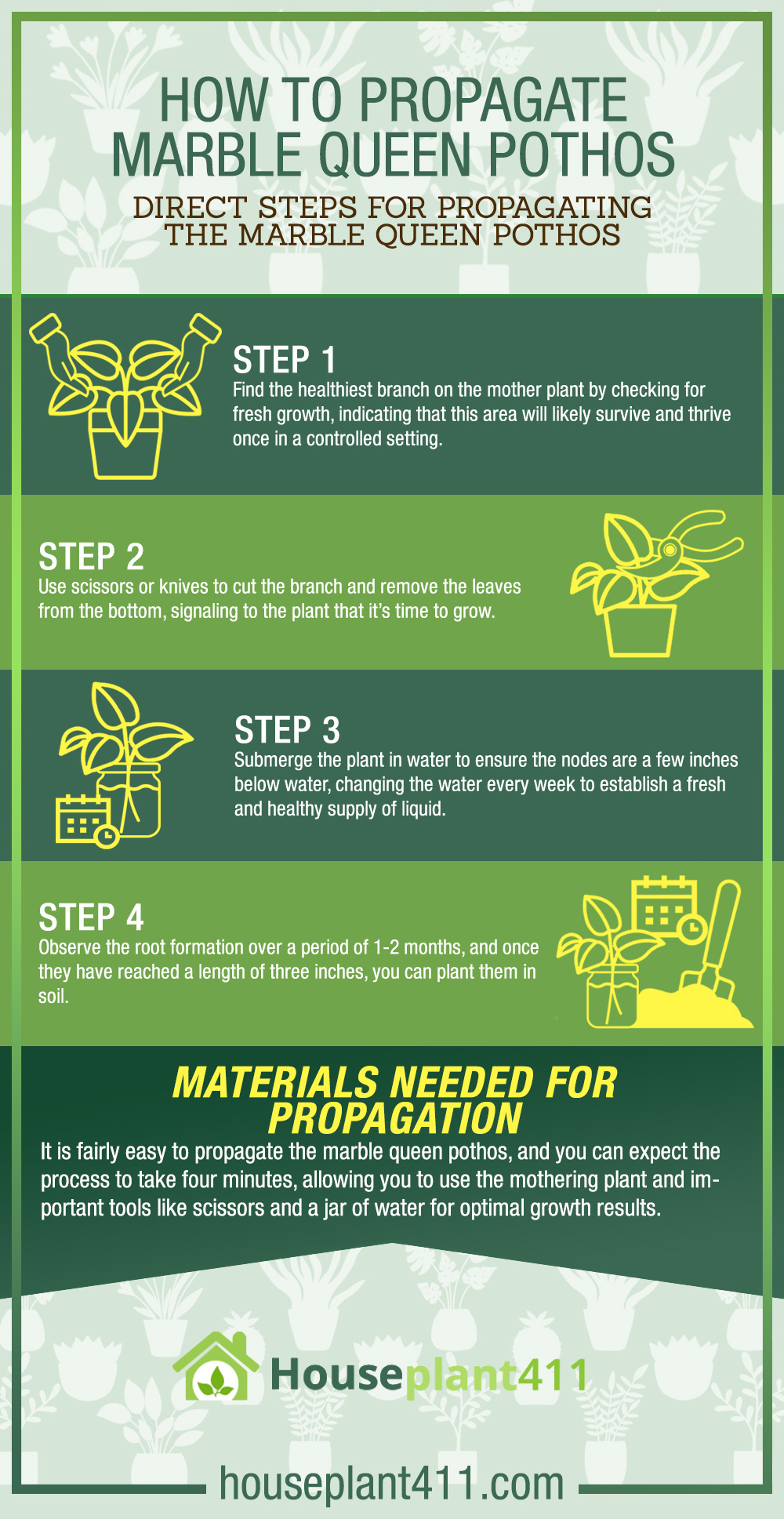Propagating your marble queen pothos is not that difficult since the plant is fairly resilient and can grow in various conditions, allowing it to thrive both indoors and outdoors.
If you’ve recently bought a marble queen pothos, you will be glad to know that there are many ways you can experiment with its growth, making it possible to decorate your home with beautiful green and white colors.
Plant enthusiasts find it joyful to undertake propagation projects like this one, ensuring they develop their interest and learn more about the ways different plants respond to propagation tactics.
One of the best ways you can achieve this is by taking several cuttings from your plant, giving it a slight trim and using those cuttings to form new plants, especially if you’re looking to learn more about growing plants indoors.
Since the marble queen pothos is a trailing plant, you can expect it to grow rapidly, which is why you should always trim it to avoid the leaves falling on the floor, using them strategically for more growth.
If you take these cuttings and put them in new pots, they will quickly develop roots and grow right in front of your eyes, creating the indoor look you are aiming for and impressing your friends with the greenery in your home.
Let’s explore how to propagate the marble queen pothos in more detail.
Marble Queen Pothos – What You Need to Know
This plant is a particular species of the tropical plant pothos, having characteristic white spots and trails on the leaves that separate it from other plants in its family.
You can expect to see various combinations and shades of white and green when growing the marble queen pothos, beautifying your home and increasing its aesthetic appeal.
Since the marble queen pothos is easy to grow and does not need much care, you will find that your house quickly gets quickly filled with long and luscious trails, allowing you to propagate this popular indoor plant with relative ease.
You may have heard this plant being called by its other names, such as the devil’s plant and devil’s ivy, but they are essentially the same species.
Let’s explore the various methods of propagating the marble queen pothos.
How Does the Marble Queen Pothos Develop Roots?
One of the quickest ways to propagate this plant is to help it grow and develop roots in water, but you should know that this variety is fairly slow compared to others in its family.
This may be a good thing because you do not want to develop roots in a week or two since that will result in rapid growth, and your home might start resembling a jungle.
Once you place the marble queen pothos in water and allow it to grow, you can expect the roots to form within a couple of months, meaning they are ready to be transferred to potting soil once the roots’ length reaches 2-3 inches.
This means the first step is to place the plant in water and allow the roots to grow, which is when you transfer it to the soil so it can take hold and propagate fully.
Soil propagation is the next step, and you must ensure that you keep the soil wet and cover it slackly with a plastic bag, allowing you to create a greenhouse effect that is conducive to root growth.
However, allowing the roots to develop in water is easier because you can easily monitor the growth and not rely on guesswork.
Propagating the Marble Queen Pothos – Rules and Conditions
This plant will grow quickly in the spring and summer time, which is when you will notice the fastest root growth. However, you can grow the marble queen pothos throughout the year by ensuring it gets adequate sunlight since it is an all-season plant.
You can expect the roots to mature in three months if you’ve placed the plant in water, and it is time to move the plant into the soil once the roots reach about two inches in length, which is easily noticeable.
However, you should ensure that the plant receives indirect sunlight since too much of it can hinder its growth and cause it to wilt in extreme cases.
Since the marble queen pothos is fairly resilient, you can easily propagate it by using its stem instead of leaves, planting the segments directly in the soil and waiting until new leaves start to develop.
If you’re wondering how long the cuttings need to be, you should ensure they are no longer than 6-8 inches. When deciding where to cut it, you should choose a healthy branch since that will likely incur excellent plant growth. The nodes are where the roots begin to form, and you should remove some nodes to elicit greater targeted growth.
Cutting around a leaf node will accelerate new growth, especially if you have fully submerged the node in water.
Direct Steps for Propagating the Marble Queen Pothos
When looking to propagate the marble queen pothos, you should follow these direct steps to elicit growth.
Step 1
Find the healthiest branch on the mother plant by checking for fresh growth, indicating that this area will likely survive and thrive once in a controlled setting.
Step 2
Use scissors or knives to cut the branch and remove the leaves from the bottom, signaling to the plant that it’s time to grow.
Step 3
Submerge the plant in water to ensure the nodes are a few inches below water, changing the water every week to establish a fresh and healthy supply of liquid.
Step 4
Observe the root formation over a period of 1-2 months, and once they have reached a length of three inches, you can plant them in soil.
Materials Needed for Propagation
It is fairly easy to propagate the marble queen pothos, and you can expect the process to take four minutes, allowing you to use the mothering plant and important tools like scissors and a jar of water for optimal growth results.
Following the steps above, you can begin to grow a fresh plant in a potting mixture by adding the rooted plant to the soil and watching it grow and propagate within weeks.

Propagating the Marble Queen Pothos Directly in Soil
Many people prefer to avoid propagating the marble queen pothos in water and instead choose to grow it in soil, which is also possible but requires a slightly different approach.
You will have to use a rooting hormone if you’re growing your marble queen pothos in soil, and choose an ideal potting mixture with well-draining soil to ensure there are no problems associated with root rot.
Similar to propagation in water, you will need to use sharp scissors to cut off stems with nodes from the mother plant. The nodes are important because that is where the roots and fresh leaves grow from, allowing your plant to thrive in the soil.
Removing the leaves from the bottom of the plant is vital, which can be done using scissors or your fingers to pull the leaves off without damaging the mother plant.
The next step is different because it involves dipping the plant in rooting hormone, which is essentially a powdered mixture that facilitates new growth in your cuttings, provided the branch is healthy.
Once you’ve completed the steps thus far, you can make holes in the potting mixture and place the cuttings in it. The potting mixture should have some drainage holes present to ensure the water doesn’t saturate the soil and drains slowly, allowing the moisture to facilitate root growth.
You should bury the nodes in the soil and keep the uppermost leaves hanging from the top, keeping the cutting in place and offering stability in your pot.
These are the complete steps to ensure you propagate your marble queen pothos optimally, especially if you are planning to avoid growing it in water, which is more common and yields better results, primarily due to the root growth being more obvious and observable.
What Conditions Are Favorable for Growing the Marble Queen Pothos?
One of the reasons why people prefer growing the marble queen pothos in their homes is because it is simple to grow and does not demand much care and attention, allowing you to yield excellent growth results by doing the bare minimum.
You should avoid placing the plant in direct sunlight as that can be too much for the plant and hinder its growth. Placing the plant in a moderate amount of sunlight is ideal, and you should keep moving the plant to encourage fresh growth.
The marble queen pothos can also grow in low light settings, meaning indirect light is the best option for growing it optimally.
The watering requirements of this species are fairly low, meaning the soil should be left to dry out completely before watering it again. Using the right watering technique, you should ensure the water soaks into the roots, and any excess water that remains in the pot should be removed by tipping the pot slightly to one side.
This plant grows optimally in warm temperatures, making it important for you to avoid placing it in cold environments. Some areas of the home can get fairly cold during winter, which is why you should keep it in a place that maintains a temperature of 65 to 85 degrees Fahrenheit for optimal growth results, especially if you’re looking to propagate it.
The humidity tolerance is fairly high for this particular species, meaning it will grow well indoors as long as it doesn’t get too dry. If some days are particularly dry, you may wish to temporarily move the plant into the bathroom to ensure it fulfills its moisture requirements. As a rule of thumb, the moisture levels should be adequate between 40% to 60%, which may be maintained by using a humidifier.
Regarding repotting the plant, you will be glad to know that the marble queen pothos can survive in one pot for a year. One indicator that it is ready to be moved into a new pot is when the soil becomes loose, and the roots start to overgrow. Consulting a repotting guide may be necessary to avoid making any serious mistakes that could jeopardize your plant’s growth.
Suppose your plant is exhibiting signs of browning or yellowing. In that case, you should take corrective action immediately because it indicates that the surrounding air is too cold or dry, making it necessary to check your home’s temperature and humidity levels. Yellow and black spots mean your plant is receiving too much water, meaning you should change your watering habits.
Although the marble queen pothos is safe for growing indoors, it can be fairly toxic to people and animals upon ingestion, which is why you should avoid eating it.
Final Verdict
Propagating the marble queen pothos is not that challenging. It only requires a few materials and tools, making it possible to proliferate its growth in your home, creating a vibrant display of green and white in your indoor garden.
The total propagation time is less than 5 minutes, meaning you can achieve remarkable results by doing the bare minimum, which is why this plant is popular and commonly grown indoors by many plant owners.
Like all plants, you should consider providing favorable conditions to ensure optimal growth and development since overwatering and too much exposure to bright sunlight can cause it to wilt and die.
The potting mixture must have some drainage additives like sand or moss to ensure the water doesn’t saturate the soil for too long and lead to root rot.
Following the steps laid out in this article will ensure that your marble queen pothos is well on its way to proliferating, allowing you to create the indoor garden of your dreams according to your preferred vibe.

